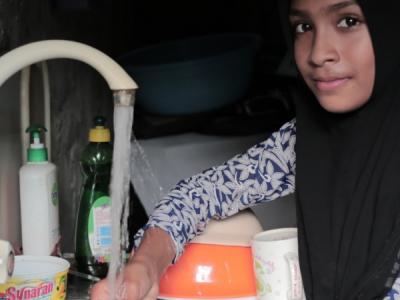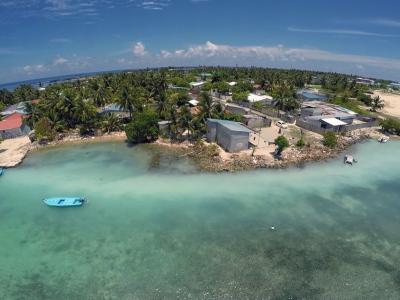According to the Intergovernmental Panel on Climate Change (IPCC) vulnerability is the degree to which a system is susceptible to, or unable to cope with, adverse effects of climate change, including climate variability and extremes (IPCC 2001:388). Adaptation refers to adjustment in natural or human systems in response to actual or expected climatic stimuli or their effects, which moderates harm or exploits beneficial opportunities (IPCC 2001:365). For the Maldives, adaptation is a multi-dimensional goal that aims to increase resilience of the vulnerable systems against climate hazards and risks to achieve sustainable development outcomes. Maldives is an archipelago of 25 lowlying coral atolls located in a north to south direction on the Laccadives-Chagos submarine ridge in the Indian Ocean. This chain is 860km long and the width varies between 80 to 120km. There are 1190 small tropical islands out of which 358 islands are being currently utilized mainly for human settlements, infrastructure and economic activities. The largest island is Gan in Laamu Atoll which is barely 6km. Maldives has a tropical monsoon climate. The south-west monsoon is from May to November and the north-east monsoon is from January to March. Daily temperature varies between 31 C and 23 C. The mean daily maximum temperature is 30.4 C and the mean daily minimum temperature is 25.7 C. Humidity ranges from 73 to 85% (MEC, 2004; Meteorology, 2006).
A. Adaptation Needs and Priorities
Maldives is an archipelago of 25 low-lying coral atolls located in the Indian Ocean southwest of the Indian subcontinent. The country’s climate is characterized as “tropical monsoon,” with monsoons occurring from May to November and from January to March (MEEW, 2007). Climate change is an existential threat to the small coral islands that make up the Maldives. Over 80 per cent of the land area of Maldives is less than one meter above mean sea level; as such, a sea level rise of even a meter would cause the loss of the entire land area of Maldives (MHAHE, 2001). In the near term, the islands of the Maldives are very vulnerable to inundation and gradual sea level rise will aggravate the existing problem of beach erosion; in the recent past, 62 per cent of all inhabited islands and 45 per cent of tourist resorts reported severe beach erosion (Shaig, 2006). Rising sea levels also threaten the scarce fresh water resources of Maldives. Salt water intrusion is gradually encroaching in to the islands’ small pockets or ‘lenses’ of fresh water underground. The coral reefs surrounding the Maldives are at risk due to gradual warming of sea water (in addition to pollution from man-made sources). Given that these reefs support both the country’s tourism and fisheries industries upon which the people depend almost exclusively, climate change is a profound threat to its very economic base.
Maldives’ National Adaptation Programme of Action (NAPA) identifies the following key areas of climate change related vulnerabilities: land, beach and human settlements; critical infrastructure; tourism; fisheries; human health; water resources; agriculture and food security; and coral reef biodiversity (MEEF, 2007).
B. National Level Policies and Strategic Documents
Maldives completed its Initial National Communication to the United Nations Framework Convention on Climate Change (UNFCCC) in 2001. In addition to identifying key vulnerabilities, this report also proposed 12 high-priority adaptation and mitigation projects, clearly recognized the finance gap and indicated that adaptation action would have to be carried out using external resources.
As a follow up, Maldives initiated its NAPA process in 2004. Progress towards it completion was immediately interrupted in December 2004 by the Indian Ocean tsunami. This single event changed Maldives’ status from a developing country back to a least developed country (LDC) and exposed how vulnerable this small country is to natural calamities. Maldives eventually completed the NAPA in 2007.
Recommendations made in Maldives’ NAPA are based on a systematic review of the risk-vulnerability context. Within it, adaptation is seen as “a multi-dimensional goal that aims to increase resilience of the vulnerable systems against climate hazards and risks to achieve sustainable development outcomes” (MEEW, 2007). After consultations with the stakeholder groups and reviewing expert assessments, Maldives came up with 12 priority adaptation projects, as summarized in Table 3. The NAPA envisioned that implementation of the adaptation activities would be overseen by the National Commission for Protection of the Environment. A special interagency task force would ensure the respective agencies of the government mobilize international financial assistance and allocate public financing to the priority project profiles in the NAPA.
In 2011, Maldives announced it had signed the world’s first Strategic National Action Plan that integrates disaster risk reduction and climate change adaptation. The policy was formulated using broad consultations with key sectors including housing, construction, environment and health, and focuses on governance and decentralization as key to the success of risk reduction and adaptation. The policy is viewed as a landmark initiative within the disaster risk reduction and adaptation communities.
It may be mentioned that Maldives is a very active and visible player in the international climate conferences and negotiation meetings. And, even though its own greenhouse gas emissions are insignificant, Maldives has declared a national ambition to become a carbon neutral country by 2020.
C. Current Adaptation Action
Compared to other South Asia countries, the number of discrete adaptation projects underway in Maldives appears to be low, although each addresses Maldives’ adaptation priorities as identified though its national policies. One project, “Integration of Climate Change risks into the Maldives Safer Island
Development Program,” explicitly addressing a priority need identified in Maldives’ NAPA. In addition, a Climate Trust Fund was established in December 2009 by the European Union and the World Bank for the Maldives. It aims to build a climate resilient economy through various mitigation and adaptation activities. The majority of projects are focused on policy formulation and integration, although the areas risk reduction, coastal zones, water, forestry and meteorology are also being addressed. Funders of these projects include the Australia, European Commission, French Global Environment Fund, Germany, the Least Developed Countries Fund (LDCF), Norway, Sweden, the United States Agency for International Development (USAID), and the World Bank.
D. Proposed Adaptation Action
Maldives identifies 12 priority adaptation actions in its NAPA, one of which is currently receiving funding through the LDCF: “Integration of future climate change scenarios into the Safer Island Strategy.” In addition, the Special Climate Change Fund (SCCF) is currently considering funding for an additional project that may address NAPA priorities. The majority of these proposed adaptation actions focus on risk reduction in coastal zones, as well as the building of infrastructure to reduce the vulnerability of coastal populations. Proposed project activities also address the areas of health, tourism, water, agriculture, nature and fisheries.
Additional References
Ministry of Environment, Energy and Water [MEEW] (2007). National Adaptation Programme of Action: The Republic of Maldives. Retrieved
Ministry of Home Affairs, Housing and Environment [MHAHE] (2001). First National Communication of the Republic of Maldives. Retrieved






